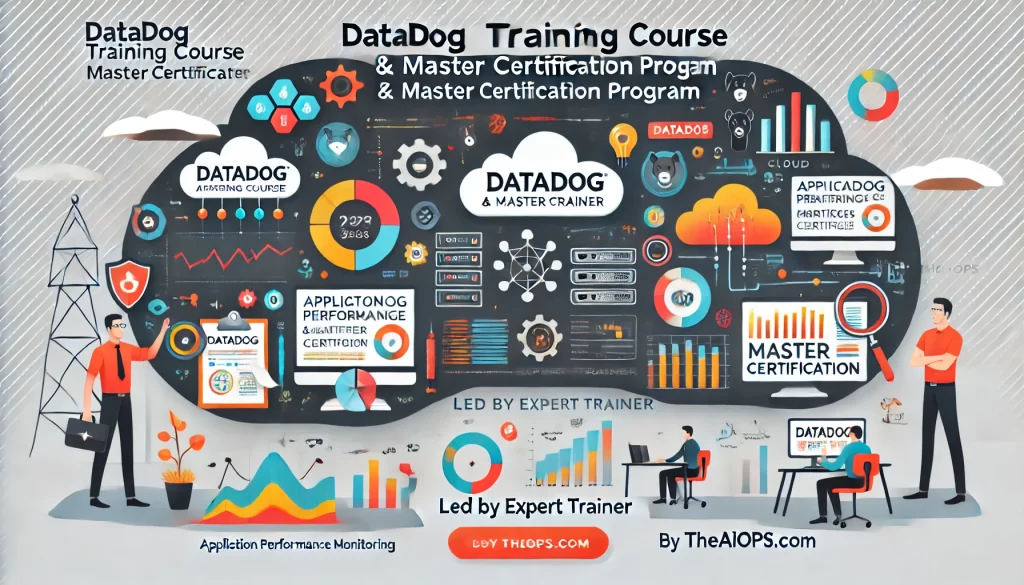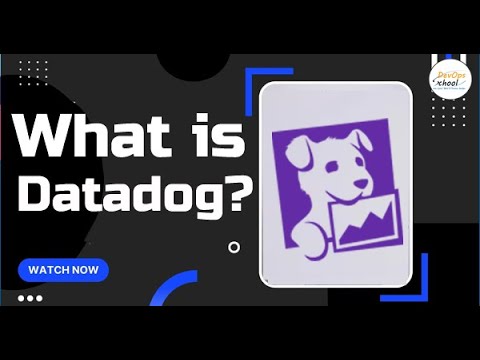
The Datadog Training Course & Master Certification Program by theaiops.com is an intensive course crafted to equip IT professionals, DevOps engineers, and cloud administrators with expert skills in Datadog, a leading monitoring and analytics platform. Led by expert trainer Rajesh Kumar from RajeshKumar.xyz, this program covers key Datadog features and best practices, including setting up real-time monitoring, managing alerts, and gaining visibility across applications, servers, and cloud resources. Through hands-on exercises and real-world scenarios, participants learn to integrate Datadog with various tech stacks, visualize metrics, and troubleshoot performance issues efficiently. By the end of the program, learners are well-prepared for the Datadog Master Certification, validating their expertise in this critical tool for observability and performance optimization. This training empowers professionals to create robust monitoring solutions that drive operational efficiency, enhance system reliability, and support data-driven decision-making in complex, cloud-native environments.
What is Datadog?

Datadog is a cloud-based monitoring and analytics platform that provides real-time visibility into IT infrastructure, applications, and logs. Datadog integrates seamlessly with a vast ecosystem of tools and services, widely used by DevOps and IT operations teams, enabling unified monitoring across cloud, hybrid, and on-premises environments. With features such as metric collection, alerting, log management, and APM (Application Performance Monitoring), Datadog helps teams track system performance, detect anomalies, and troubleshoot issues efficiently. Its customizable dashboards allow for in-depth visualization of data, making it easy to monitor critical KPIs and understand application health at a glance. By centralizing and analyzing data from multiple sources, Datadog enables organizations to improve operational efficiency, ensure system reliability, and respond proactively to incidents, making it an essential tool for managing complex, dynamic IT environments.
Why Datadog is Important
In the era of cloud-native and microservices architectures, Datadog has become an essential tool for IT operations, DevOps, and security teams. Here are some of the core reasons why Datadog is so critical:
- End-to-End Visibility Across Environments: Datadog provides a holistic view of infrastructure, applications, and users in real time, allowing teams to see how each part of the system impacts the other. This comprehensive visibility is crucial in multi-cloud and distributed environments where complexity can lead to blind spots.
- Proactive Issue Detection and Reduced Downtime: Datadog’s real-time monitoring and alerting help teams catch issues before they impact users. Alerts can be customized to notify teams of unusual spikes, errors, or performance degradations, reducing downtime and improving reliability.
- Optimized Application Performance: With APM, Synthetic Monitoring, and RUM, Datadog enables teams to deliver optimal application performance, ensuring that users experience high availability and fast response times. This is especially important for customer-facing applications where poor performance can impact user satisfaction.
- Security and Compliance: Datadog Security Monitoring integrates directly into cloud infrastructure, enabling teams to identify, monitor, and mitigate security risks in real-time. This is vital for organizations in regulated industries that must comply with data protection standards.
- Scalability for Any Environment: Datadog is designed to scale with infrastructure, making it suitable for startups, large enterprises, and complex distributed systems alike. Whether an organization uses a hybrid, multi-cloud, or on-premise environment, Datadog adapts seamlessly.
- Facilitates Collaboration: By centralizing monitoring data and providing tools like dashboards, logs, and traces, Datadog enables better collaboration between DevOps, IT operations, and security teams, helping them align on incident management and performance goals.
Course Features
This Datadog training course is tailored to provide a deep dive into Datadog’s capabilities, equipping participants with practical skills for implementing and managing robust monitoring and observability solutions.
- Comprehensive Curriculum: The course spans Datadog’s full range of features, covering infrastructure monitoring, application performance management, log management, and security monitoring. The curriculum is designed to provide a strong foundation in both basic and advanced concepts.
- Hands-On Labs with Real-World Scenarios: Each module includes lab exercises that mirror real-world applications. Participants will configure Datadog agents, set up dashboards, create custom alerts, and explore security integrations.
- Case Studies and Industry Examples: Throughout the course, participants will review case studies from various industries, such as finance, e-commerce, and healthcare, to understand how Datadog is applied to solve specific business challenges.
- Lifetime Access to Course Materials: Participants receive lifetime access to all course resources, including recorded sessions, practical guides, and lab setup instructions. This ensures they can continue learning and revisiting materials as they advance in their roles.
- Expert-Led Training: Led by Rajesh Kumar, a seasoned professional in cloud monitoring and DevOps, this course offers practical knowledge, industry insights, and mentoring from an experienced trainer.
Training Objectives
The Datadog training course is designed to provide participants with a thorough understanding of Datadog’s core functions and how to apply them effectively. By the end of this course, participants will be able to:
- Set Up and Configure Datadog Environments: Install Datadog agents, configure integrations, and monitor various system components, from cloud instances to on-prem servers and applications.
- Monitor Applications and Infrastructure: Use APM, log management, and infrastructure monitoring to track performance metrics, troubleshoot issues, and optimize resources.
- Create Custom Dashboards and Alerts: Develop dashboards tailored to specific needs, configure alerts for proactive monitoring, and implement thresholds that trigger real-time notifications.
- Implement Security Monitoring: Configure Datadog’s security monitoring features to detect vulnerabilities and ensure compliance, adding an extra layer of defense to your systems.
- Simulate and Monitor User Experience: Set up synthetic and real user monitoring to analyze and optimize user experience, ensuring seamless interactions with applications.
Target Audience
This course is ideal for a variety of IT professionals seeking to strengthen their monitoring and observability skills:
- System Administrators and IT Operations Teams: Professionals responsible for maintaining infrastructure health and availability will benefit from Datadog’s infrastructure monitoring capabilities.
- DevOps Engineers: Engineers involved in CI/CD, automation, and application delivery will learn how to integrate monitoring into their pipelines and support high-performance applications.
- Cloud Architects and Cloud Engineers: Cloud professionals who design, build, and maintain cloud environments will gain skills in monitoring cloud-native resources, improving scalability, and ensuring reliability.
- Security Engineers: Security-focused participants will learn how to use Datadog’s Security Monitoring to detect threats and maintain compliance.
- Application Developers and Performance Engineers: Developers and engineers focused on application performance will gain insights into improving user experience and troubleshooting performance issues.
Training Methodology
The Datadog course combines theoretical learning with hands-on exercises, ensuring a balanced and engaging experience:
- Lecture-Based Theoretical Sessions: Conceptual sessions cover Datadog’s architecture, setup, and best practices, providing a solid foundation in observability and monitoring principles.
- Hands-On Labs and Practical Exercises: Participants gain practical experience by working directly with Datadog’s tools, configuring agents, setting up custom dashboards, and monitoring real-time environments.
- Project-Based Assignments: Simulated projects and case studies enable participants to apply their knowledge in scenarios reflective of real-world challenges.
- Interactive Q&A and Collaborative Discussions: Participants have the opportunity to ask questions, discuss challenges, and share experiences with peers, fostering a collaborative learning environment.
- Assessments and Feedback: Regular quizzes, assignments, and feedback help reinforce learning, ensuring participants develop strong, applicable skills.
Certification Program
Upon course completion, participants will receive a certification from DevOpsSchool.com, validating their knowledge and skills in Datadog monitoring and observability:
- Industry-Recognized Certification: This certification confirms participants’ proficiency in Datadog, helping to demonstrate their expertise to employers.
- Digital Badge for Professional Profiles: Participants will receive a digital badge that can be added to LinkedIn profiles, resumes, and professional websites.
- Lifetime Verification and Access to Certification Resources: Participants can access their certification information at any time, ensuring ongoing support for their career advancement.
Agenda of Datadog Training Program
Day 1: Introduction to Datadog and Infrastructure Monitoring
- Understanding Datadog’s Core Features: Overview of Datadog’s functionalities and architecture.
- Agent Installation and Configuration: Installing Datadog agents, integrating with cloud providers, and setting up basic monitoring.
- Infrastructure Monitoring: Configuring infrastructure monitoring for servers, cloud resources, and containers.
- Hands-On Lab: Setting up Datadog to monitor cloud infrastructure and visualize metrics on custom dashboards.
Day 2: Application Monitoring, APM, and Log Management
- Application Performance Monitoring (APM): Configuring APM to trace requests, monitor performance, and diagnose bottlenecks.
- Log Management: Setting up log management, correlating logs with application metrics, and analyzing logs for troubleshooting.
- Alerting and Incident Management: Setting thresholds and alerts, and configuring notifications for critical events.
- Hands-On Lab: Deploying APM for a sample application, setting up alerts, and visualizing performance metrics on a dashboard.
Day 3: Synthetic and Security Monitoring, Real User Monitoring
- Synthetic Monitoring: Configuring synthetic monitoring to simulate user interactions and test critical application workflows.
- Real User Monitoring (RUM): Tracking real user sessions to understand user behavior and identify performance issues.
- Security Monitoring: Setting up security alerts, monitoring for vulnerabilities, and ensuring compliance.
- Hands-On Lab: Configuring synthetic and RUM monitoring for a sample application, setting up security monitoring, and creating a comprehensive dashboard for real-time insights.
Lab Setup
To enable hands-on practice, participants will set up a lab environment that includes:
- Required Software: Datadog agents, sample applications (provided), and access to a cloud platform or on-prem servers for monitoring.
- Hardware Requirements: A system with at least 8GB RAM, a multi-core processor, and stable internet.
- Cloud or Local Setup Options: Labs can be configured on AWS, GCP, or Azure, or locally if preferred by participants.
- Step-by-Step Setup Guide: Detailed setup instructions will be provided to ensure smooth configuration and participation in labs.
Trainers
This course is led by Rajesh Kumar, a DevOps and cloud monitoring expert with extensive experience using Datadog for real-world applications. Rajesh’s practical teaching style ensures that participants gain actionable knowledge and skills, making them ready to implement Datadog in their organizations.
Frequently Asked Questions (FAQ)
- What prior experience is required?
- No prior experience with Datadog is needed, but familiarity with IT infrastructure and monitoring concepts is helpful.
- What types of infrastructure does Datadog monitor?
- Datadog monitors servers, applications, cloud resources, containers, networks, and more, supporting both cloud and on-prem environments.
- Will I get hands-on experience?
- Yes, each module includes hands-on labs for real-time Datadog configuration and usage.
- How does Datadog support application monitoring?
- Datadog APM provides request tracing, dependency visualization, and performance optimization for applications.
- Is Datadog suitable for security monitoring?
- Yes, Datadog Security Monitoring provides real-time threat detection and compliance tracking.
- Will I receive a certification?
- Yes, participants will receive a DevOpsSchool.com certification upon completion.
- Can I revisit the materials after the course?
- Yes, participants have lifetime access to course resources and recorded sessions.
- Does Datadog offer synthetic monitoring?
- Yes, synthetic monitoring simulates user workflows, helping teams ensure critical paths are functional.
- What’s the role of Real User Monitoring (RUM)?
- RUM captures live user interactions, allowing teams to monitor performance from the user’s perspective.
- How does Datadog handle log management?
- Datadog centralizes logs, allowing correlation with metrics and easy root cause analysis.
- Are there projects in the course?
- Yes, simulated projects allow participants to apply their learning in realistic scenarios.
- Does Datadog integrate with cloud platforms?
- Yes, Datadog integrates seamlessly with AWS, GCP, Azure, and more.
- Is Datadog suitable for large-scale environments?
- Yes, Datadog’s architecture scales to handle complex and distributed systems.
- Can Datadog help with compliance?
- Yes, Datadog’s security monitoring helps track compliance by monitoring security events and configurations.
- What kind of support is available for labs?
- The course includes detailed lab instructions, and support is available for troubleshooting and setup assistance.
